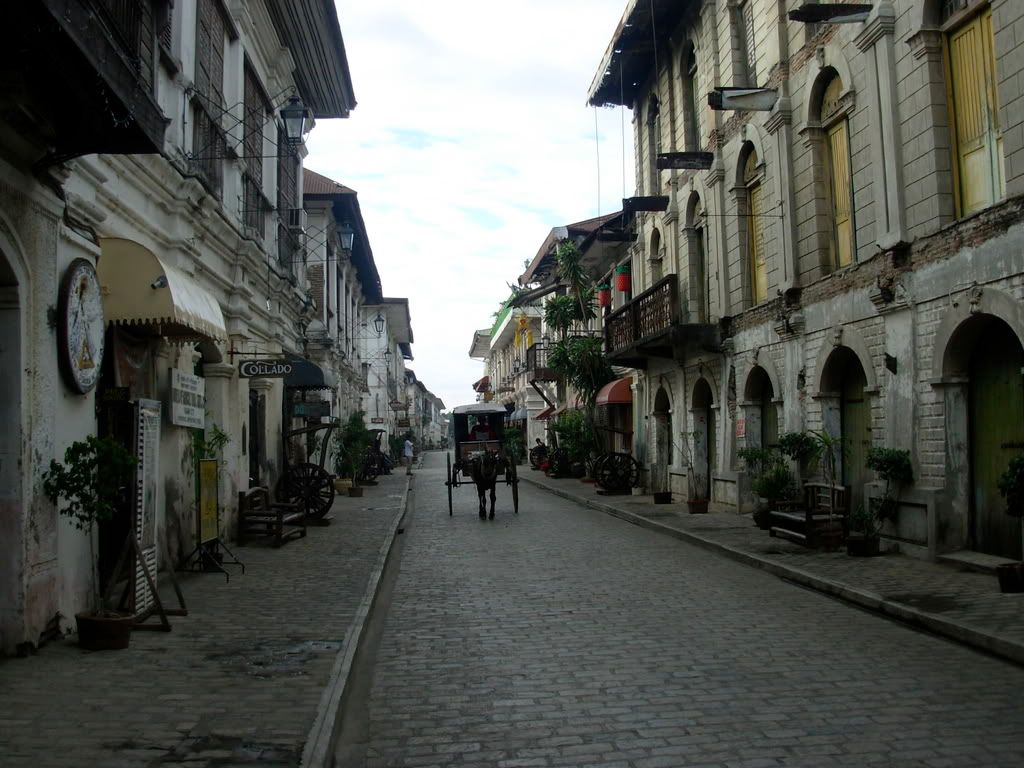vigan is a UNESCO world-heritage site. and after our disappointment regarding the general lack of information (historical and otherwise) in palawan, it was a pleasant change. the city has preserved a whole section of town, called the kasanglayan district, leftover from when it was a spanish colony. so you get cobbled streets and these old, beautiful homes lining the streets. it's also one of the few areas where the kalesa (horse-drawn carriage) is still commonly used for transportation (locals use them too! not just for tourists!).


[kalesa]
the place has tons of museums and old houses that you can wander through. museums here are ... very odd. there seems to be no organization (or at least any noticeable one). most seem to be collections of whatever people found lying around, thrown into a room. often there is no linearity or apparent linearity or labels telling you exactly what it is that you're looking at. it's very odd. we went to the house of father burgos, and even received a guided tour, but i still couldn't tell you who the guy was or why he was so important. i asked, and our guide said that he was part of an uprising against the spanish. and that's it. even when you press for more information, it is still hard to come by. i really think that in this country you have to ask the exact question for what you want to know. otherwise, forget it.
guided tours here are, in general quite odd, and i think we'll be avoiding them in the future. i feel so rushed when there's a guide. through burgos' house, the guide was full of information, but she ran us through the rooms, even when brad and i were trying to pause and look at things more closely (we even said so, but to no avail). this museum even had labels, but we didn't get to read any of them. we've also had "guided tours" where the guide doesn't say a word, just follows you around, practically breathing down your neck, and only points you to where you are supposed to go next. regardless, i did love wandering through the church and houses, seeing the "artifacts" (although i don't think that every single plaque that some member of the crisologo family received is that important. i couldn't tell you why the family is important either, to be honest. or the heaps of virgin and child statues in the church museum (why so many!?)) and seeing the architecture – an interesting mix of spanish and chinese with a few filipino touches.

[the windows are my favorite; they're paned with thin shells which are strong enough to withstand typhoons, but still let in a lot of sunshine]


vigan is also the center of production for burnay pots, which are used to ferment the local basi (sugarcane wine) and bagoong (fish paste). we tasted some of each – wine much too sweet, i think, but still interesting; and fish paste just ... salty and not very appealing. we visited two different factories, with just HEAPS of pots lying around and huge kilns to make them. pretty cool. too bad they're so heavy. shopping for souvenirs is hard.
the best (or close to it) part of vigan, though, was the empanadas and the bibingka. the empanadas are like a mix between tacos and spanish empanadas, but still have a unique flavor. the empanadaan is an area in the center of town which houses a lot of stands where you can watch women making them and then buy fresh ones to eat. and oh my goodness they are delicious and served with homemade vinegar with chilis. yum!

and bibingka is a (surprise surprise) rice delicacy made from glutinous rice and coconut and is delicious. hard to describe other than that, i'm afraid ... most things here seem to be made of a combination of rice, coconut, butter, and sugar, and yet they still manage to have unique flavors. amazing. i'll try to find a recipe so i can attempt to make it when i get home. although i have no idea how i'll find the "right kind" of rice – you wouldn't believe how many different kinds of rice you can buy here.
suffice it to say that brad and i ate a lot of empanadas and bibingka.
i must also mention our rather bizarre new year's experience. we arrived in vigan the morning of the 31 and so spent a great part of the day checking out restaurants that we could go to for dinner. we figured that we'd have a late dinner at a restaurant and toast in the new year there (just as you can in the states). but ... all the restaurants told us that they were closing at nine, which made brad and i wonder if filipinos even celebrate new years. i mean, we figured it was kind of a worldwide tradition to stay up until midnight, but maybe not so much here. so we went to the grocery and bought a bottle of sparkling wine and planned on just celebrating at the hotel. so after dinner, we go back to the hotel and there are people everywhere setting off fireworks and firecrackers. really unbelievable amounts and so, so much noise. brad and i were actually scared to go outside for fear of accidentally being blown up (and read in the newspaper the next day that only 450-ish people had been injured this year, down more than 50% from last year!!!). but it answered our question – filipinos celebrate the new year by setting off fireworks and crackers – apparently to scare off bad luck/demons for the upcoming year.
we spent three and a half days in vigan and it was wonderful – a really beautiful city. and for once, we managed to relax a little bit and not run around quite so much.
No comments:
Post a Comment